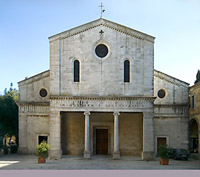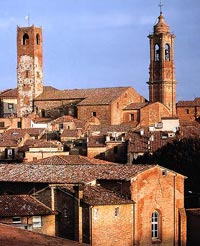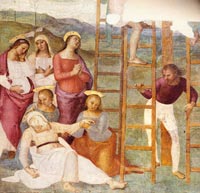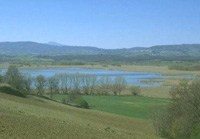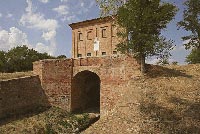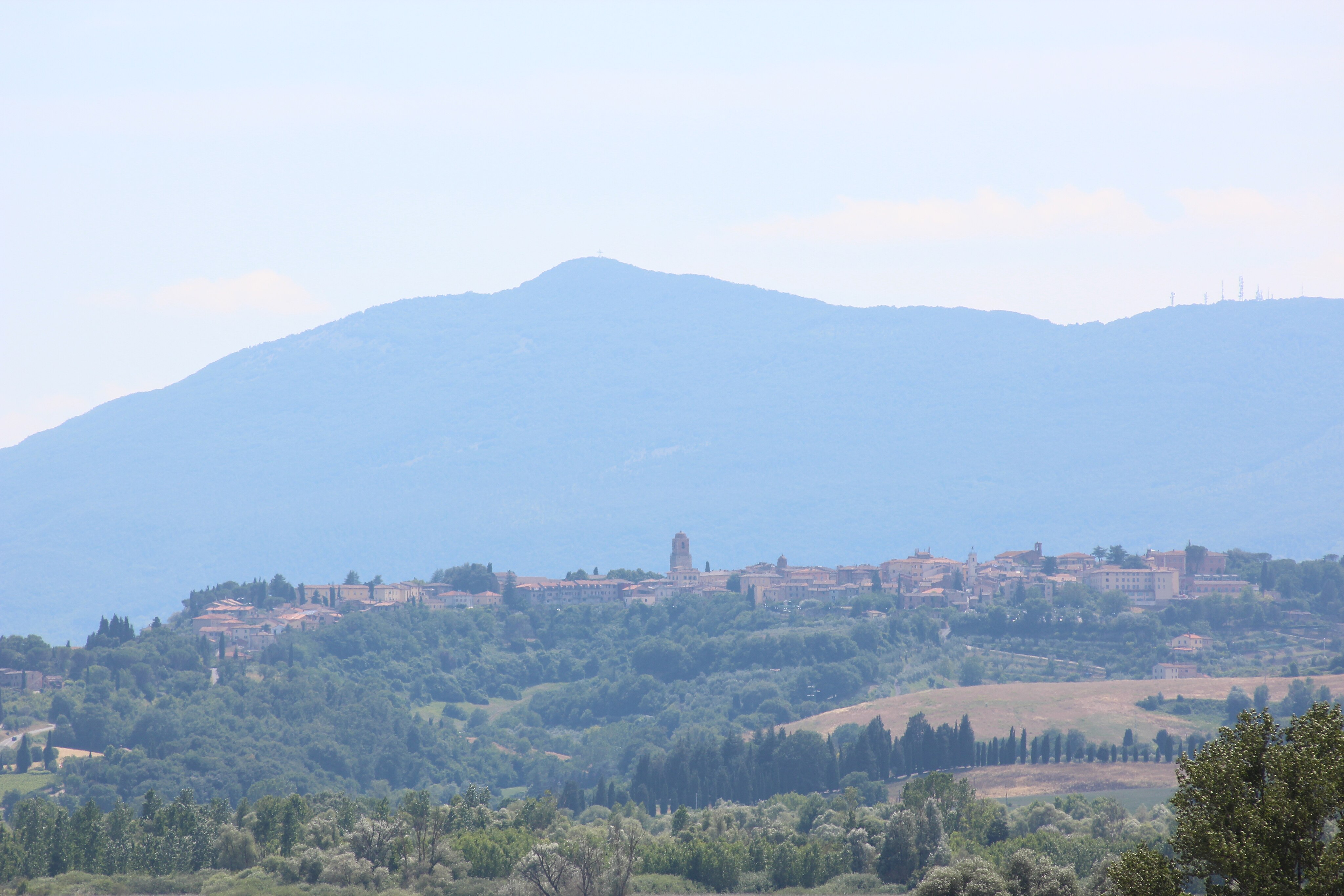 |
|
| N L | Panorama of Chiusi, in the background Monte Cetona, Province of Siena [0] |
|
| Chiusi is situated in a very strategic location, midway between Rome and Florence, between Montepulciano and Orvieto. Chiusi, was one of the most powerful cities in the Etruscan league, reaching the 7th and 6th centuries BC. Its origins come back to the first millennium B.C. Between the 6th and the 7th centuries B.C. it became one the most important cities in the Etruscan League. Under the leadership of the Etruscan king Porsenna this League was powerful enough to attack Rome. Etruscan allied with Romans in the 1st century and the city changed its name into Clusium. There is a large number of Etruscan tombs in the surrounding countryside. The Museo Nazionale Etrusco is one of the most important repositories of Etruscan remains in Italy. The Museum also provides guided visits to the main Etruscan tombs in the very nearness of the town, like Tomba della Scimmia and Tomba del Leone. The Romanesque cathedral, the Duomo of San Secondiano, is opposite the museum and built from recycled Roman pillars and capitals. There is an authentic Roman mosaic underneath the high altar. The Duomo dates back to 560AD on the site of an earlier basilica. Although renovated in the 13th century and much decorated in the 19th, the marble columns, mosiac floor and alabaster font are all Roman. The Museo della Cattedrale has a collection of codices and illuminated religious books from the 15 and 16C, coming from the Abbey of Monte Oliveto Maggiore, gold and silver ware, reliquaries, and religious ornaments. Paintings such as “Madonna and Child” by Sano di Pietro (1406-1481), whose subject was picked up by other artists who worked in the cathedral later, such as Girolamo di Benvenuto (1470-1524). Another significant painting is the 'Blessing of Christ' by Matteo Rosselli (1578-1650). The museum leads into the Labyrinth of Porsenna, a series of tunnels beneath the town, dating from the sixth century BC and probably utilized in Etruscan-Roman times for drainage of rain waters. The catacombs of Santa Mustiola and Santa Caterina d’Alessandria, 2km out of town and used by fourth and fifth century Christians, were discovered in 1634 and 1848. The Catacombs of Santa Mustiola and Santa Caterina belong to Roman Period, as well as the great water cistern. In the 13th century, a defence tower was built over it. Later, at the end of the 16th century, this was converted into a bell tower. A vast network of Etruscan tunnels stretch underneath the town. Part of these have been cleared of debris and can be now explored as part of an unusual and fascinating guided tour. This underground world comprises Porsenna's Labyrinth and the Epigraph section in the Civic Museum, with a great Etruscan well overlooking a pool of 30 meters depth. The Church of Saint Francis, situated along the Via Paolozzi and built entirely in brick according to the severe style of the Franciscan church and probably built between the 13th and 14th centuries. Inside it houses a fresco depicting the Beheading of St. John the Baptist by Niccolò Circignani (known as the Pomarancio - 1530-1597 ca.). Events in Chiusi Feast of Santa Mustiola patroin saint, from June 26 to July 3. Etruscan market on the last Sunday of the month. Weekly market on Tuesday morning |
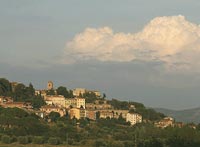 Chiusi
|
|
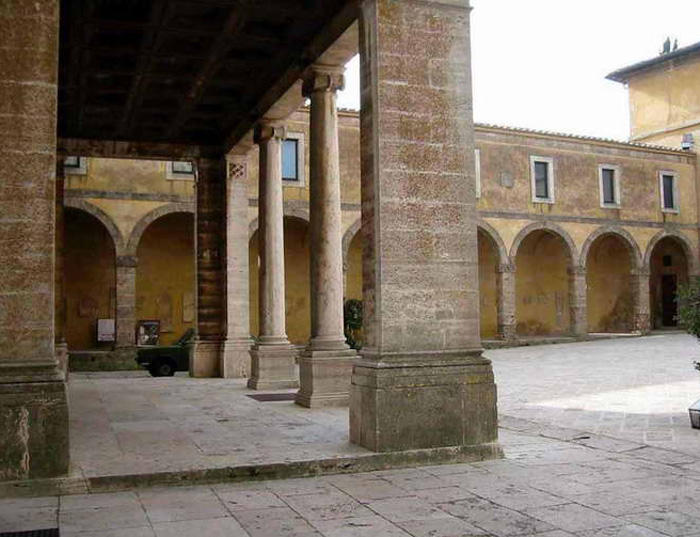 |
||
Chiusi
|
||
| Surrounded by and overflowing a double ring of medieval city walls, Sarteano is a small hill town in southern Tuscany on the ridge of Mount Cetona. Sarteano is crowned with the ruins of a castle, rocca, dating from around 1100. There are a number of ancient churches in the town, including the 16th century (ex) Convent of Santa Chiara, the San Francesco church, with a 13th-century Renaissance facade and remains of a cloister with mullioned windows, and the San Martino in Foro which, transferred from its original position on the town square to its present one, was redesigned in neoclassical style in 1841. Other historical monuments include the town hall, the Arrischianti theatre, Palazzo Piccolomini, Palazzo Goti-Fanelli, Palazzo Cennini and Palazzo del Podesta. [read more] | 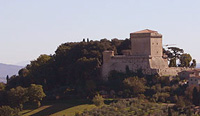 Rocca di Sarteano |
|
| Cetona is of Etruscan origin and is built along circular lines following the sides of the hill on which it stands. The square tower of the fortress is dated between 900 and 930 while the round towers date back to 1458. The following buildings are worth noting: SS.TRINITA': built between 1417 and 1475 it contains a cycle of frescos by Pinturicchio. THE CHURCH OF S.MICHELE ARCANGELO: a structure from 1155 with Sienese school frescos attributed to Cola Petruccilli who also worked on the crypt of Orvieto Cathedral. PALAZZO VITELLI: built in the second half of the 16th century. [read more] |
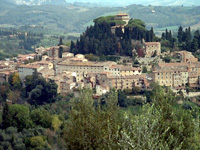 Cetona |
|
| Città della Pieve, is situated on the border of Umbria and Tuscany, 11 km south of Chiusi, in the heart of ancient Etruria. Although the town has archaeological remains from the 6th century BC, the main period of growth was in the 7th and 8th centuries AD. From 1188 Città della Pieve was dominated by Perugia. In 1450 Città della Pieve was the birth place of Pietro Vannucci, called Il Perugino, disciple of Verrocchio and maestro to Raffaello. The most important buildings were erected between the XIIIth and XVIth centuries, and bricks were used in their construction, since Città della Pieve had been a major brick-work production centre since the Middle Ages. The heart of the town is Piazza Gramsci, where the Duomo, Palazzo della Crogna and the Torre Civica are found. From the Piazza we reach the Chiesa di Santa Maria della Mercede, where in the oratorio one of the best woks of Il Perugino, Adoration of the Magi, is found. Besides a number of rnasterpieces Perugino, such as the Adoration of the Magi (1504), the Descent from the Cross (1517), the Madonna in Glory (1514), and the Baptism of Christ (1510), Città della Pieve also hosts several fine works by Domenico Alfani, Antonio Circignani, known as Pomarancio and Savini. In 1550, Pope Julius III assigned the government of Città della Pieve to Ascanio Corgna, determining the arrival of artists mainly engaged in construction and decoration of the magnificent palace that takes his name. Located in the historic centre, opposite to the Cathedral, the Palazzo della Corgna, strongly desired by the Corgna Ascanio to give prestige to the Governance, was completed by his nephew Diomede. The project is attributed to Galeazzo Alessi; the interior is richly frescoed by Pomarancio and Salvio Savini (1580) with mythological paintings in the Tuscan-Roman late-Mannerist style. From the middle of the 14th century, various monastic orders settled outside the city walls and built the convents of Sant'Agostino, San Francesco, Santa Lucia and Santa Maria dei Servi. These convents today house some of the finest paintings by the Sienese School, painters such as Simone Martini, Jacopo Mino del Pellicciaio and Pietrto and Ambrogio Lorenzetti. Outside the city walls are two churches: the Sant’Agostino church from the 14th century, with paintings by Niccolò Circignani and Salvio Savini. The small original gothic, now barock, church Santa Maria dei Servi fuori Porta Romana is decorated with Perugino's great fresco la Deposizione della Croce (1517). The Madonna della Sanità is an old hermitage in the countryside near Città della Pieve, about 2,5 kmout of town (along the SS 71, a highway that will take you to Monteleone d' Orvieto and Ficulle). The chapel has a handsome Romanesque tympanum and a fairly good painting by a pupil of Perugino. Panicale, which is a small medieval village between and Perugia, fortified with ancient walls and gates, is one of the most beautiful natural terraces in Umbria, where one can admire magnificent views of Lake Trasimeno, on one side, and the Valley of Nestore on the other. |
|
|
| Events in Città delle Pieve |
||
| Palio dei Terzieri | From 10th August to the second-to-last Sunday of the month The three sectors of town, called Terzieri (Borgo Dentro, Casilino, Castello), replaying the ancient disputes that have characterised the life of the city since the Middle Ages, challenge each other to an archery competition, The Bull Hunt (inspired by the Caccia del Toro, a primitive bullfight that took place in the ancient Castel della Pieve in the 15th and 16th century), the target being the rotating outline of a bull. The contest is preceded by a historical procession of about 700 participants in Renaissance costume. For the occasion, the old tavern are opened, serving typical Umbrian and Tuscany dishes. Palio dei Terzieri | www.paliodeiterzieri.it |
||
| Tomba della Scimmia (Tomb of the Monkey) |
||
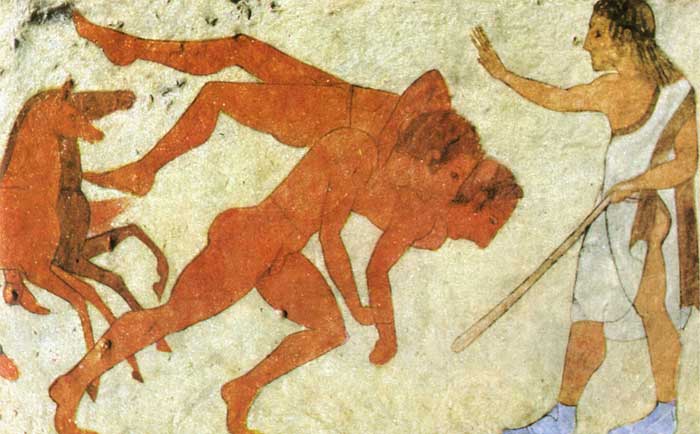 |
||
Chiusi, Tomba della Scimmia (Tomb of the Monkey) |
||
| Between the Etruscan tombs, most remarkable are the Tomba della Pellegrina, the Tomba della Scimmia and the Tomba del Leone. Discovered in 1847 by Alexandre François, the Tomb of the Monkey in Chiusi is cross shaped like several other tombs of that period, such as the tomba del Colle. This shape possibly reflects the style of Etruscan houses of the time. The tomb is carved into the Tufa, similar to those in Tarquinia. The polychrome frescoes of the Tomb of the Monkey (named after the picture of a monkey on a tree in the entrance chamber) show a similar theme to the well known frescoes in the Tomb of the Juggler in Tarquinia. Although the artwork is not as well executed as those in Tarquinia, it was probably a copy of the latter tomb made by local artisans in Chiusi. The tomb shows that women also participated in athletic competition, and also depicts a red robed lady with chitonous veils, a spectator, who is sitting on a stool under a parasol watching the actions of the jugglers, dancers, athletes, boxers and chariots etc.Directly in front of her, is a female dancer who is whirling around while balancing an incense burner on her head, accompanied by an aulos player beside a large basket.[1] |
||
| The Tomba del Colle Casuccini (or also "del Colle") is one of about fifteen painted Etruscan tombs known in Chiusi, located east of the town, near the present cemetery. The Tomba del Colle is again visible to the public after 36 years. The tomb is one of the major Etruscan tombs located on the Archaeological Promenade (la Passeggiata Archeologica) that connects the National Etruscan Museum of Chiusi to Chiusi citycenter. The tomba del Colle, dating to the sixth century BC has frescoes similar to those of the Tomb of the Monkey. The walls are decorated with a continuous frieze with a procession of dancers with rattlesnakes, athletes, boxers, wrestlers, with a chariot race and a banquet scene. The Tomb of the Hill is open to small groups after consulting the Etruscan Museum. |
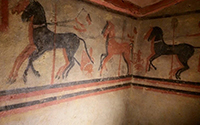 Chiusi, Tomba del Colle |
|
| The Archaeological Park of Chiusi |
||
| A few kilometres away, marking the southern border of the Val di Chiana, lies Chiusi lake, a peaceful mirror of water, set amongst screens of canes and cultivated fields, where visitors can practise leisure fishing and bird watching. Labirinto di Porsenna Opening times | From 1st June to 15th October: 10.00 am-12.45 pm and 4.00 pm-6.00 pm. From 16th October to 31st May: 10.00 am-12.45 pm (working days); 10.00 am-12.45 pm and 3.30 pm-6.00 pm (Sundays and public holidays Between the 7th and 5th centuries BC, Chiusi was one of the most important towns in the Etruscan Dodecapolis (“league of twelve cities”). In his Naturalis Historia, Pliny the Elder tells that the legendary Etruscan king Porsenna was buried in a majestic tomb inside an unfathomable labyrinth; and according to a medieval legend, the sarcophagus was guarded inside a golden chariot pulled by 12 golden horses, watched over by a hen and 5,000 chicks, also made of gold. For a long time, folk tradition had it that Porsenna’s burial place was the network of galleries that unwind beneath Chiusi. In reality, these are an Etruscan aqueduct, consisting of passageways of different sizes (around 1 metre wide and 2-5 metres high), laid out on different levels, where the water, after filtering through the rocks, was collected in large basins and drawn from wells. The route starts from the Museo della Cattedrale (Cathedral museum) in Piazza Duomo, and finishes up in a large round Etruscan-Roman reservoir from the 1st century BC with a double barrel vault held up by a central column. The structure is made from dry stone walls of blocks of travertine which are covered in cocciopesto, a mixture of pottery fragments held together by lime, ensuring they were perfectly watertight. From the tank you go up a small spiral staircase to the base of the defensive tower built in the 12th century which was transformed into a bell tower when a bell was added at the end of the 1500s. From the top of the tower you can enjoy a splendid view: the picturesque roofs of the historical centre of the town, the medieval fortress, the lakes of Chiusi, Montepulciano and Trasimeno, the Amiata and Cetona mountains, Città della Pieve, Cortona and Orvieto. |
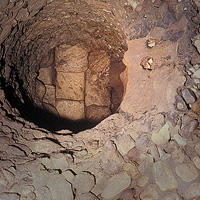 Labirinto di Porsenna |
|
Galleria delle Fonti dell'Abbondanza Tombe Etrusche, about 3 km from the historic center - ticket office in the Museo Archeologico Nazionale. Tomba della Scimmia, about 3 km from the historic center - ticket office in the Museo Archeologico Nazionale. Museo della Cattedrale Labirinto di Porsenna, Piazza Duomo. Etruscan Tunnels, reservior Etruscan-Roman and bell tower - entrance from the Museum of the Cathedral. |
||
|
||
Città della Pieve borders the municipalities of Allerona, Castiglione del Lago, Cetona, Chiusi, Fabro, Monteleone d'Orvieto, Paciano, Piegaro and San Casciano dei Bagni.From Panicale towards the dearly-loved hills of the painter "Il Perugino" Comuni of the Province of Siena | Abbadia San Salvatore · Asciano · Buonconvento · Casole d'Elsa · Castellina in Chianti · Castelnuovo Berardenga · Castiglione d'Orcia · Cetona · Chianciano Terme · Chiusdino · Chiusi · Colle di Val d'Elsa · Gaiole in Chianti · Montalcino · Montepulciano · Monteriggioni · Monteroni d'Arbia · Monticiano · Murlo · Piancastagnaio · Pienza · Poggibonsi · Radda in Chianti · Radicofani · Radicondoli · Rapolano Terme · San Casciano dei Bagni · San Gimignano · San Giovanni d'Asso · San Quirico d'Orcia · Sarteano · Siena · Sinalunga · Sovicille · Torrita di Siena · Trequanda |
||||
One of the best road bike itineraries in the region leaves from Chiusi following 46.5 km (29 miles) of paved road past both the lakes of Chiusi and Montepulciano, with other routes taking you south to Monte Cetona and over to Lago Trasimeno in Umbria. There’s also a 46-km (29-mile) loop through Salcheto, Pozzuolo, Binami, Mugnanese, Gioiella, Valiano and back to Chiusi. Stop off in Valiano and you can visit the UISP Lega Ciclismo Val di Chiana Cycling Association a mine of information on cycling in the territory. |
||||
| From Panicale towards the hills of the painter Il Perugino, trough Panicale, Sant’Arcangelo, Mugnano, Fontignano and Paciano. |
||||
| The small medieval town of Panicale is situated in an extremely panoramic, hilltop position overlooking Lake Trasimeno. Visitors to the town should not miss the Palazzo del Popolo, the Collegiate Church of San Michele, the San Sebastiano Complex and the Cesare Caporali Theatre. The ancient village of Paciano, the centre of which is enclosed by a fourteenth-century wall complete with towers and three entrance gates, is situated in the midst of beech, oak and chestnut woods. Montalera Castle, an ancient fortress, has preserved its flat-topped battlemented towers and its defensive walls, and there are still remains of its ancient moat and drawbridge. The living quarters have since been transformed into a splendid Renaissance palazzo. The village of Fontignano boasts the tomb of the famous Renaissance artist from nearby Città della Pieve, Pietro Vannucci, better known as Il Perugino, who it is said was called upon to paint frescoes in the village church, only to die there of the plague, and to be subsequently buried in the vicinity of the Church of the Annunciation. An investigation conducted in 1911 resulted in the identification of the artist’s tomb and remains. [read more] |
 Panicale |
|||
| From Chiusi to San Casciano dei Bagni |
||||
Leaving Chiusi and walking down the slopes of the Cetona Mount, the homonymous medieval town, that still preserves part of its ancient walls, can be reached. Near Cetona, in the Valverde locality, it is possible to visit the Prehistoric caves and the ex-convent of Santa Maria Valverde. |
||||
| The Sentiero della Bonifica | The Canale Maestro della Chiana |
||||
| The "Sentiero della Bonifica" (path of reclamation) is situated between Tuscany and Umbria, creating a connecting bridge between the lands of Arezzo, Siena and Perugia, by following the river of the "Canale Maestro della Chiana". It is a foot and cycle route of about 62 kmIn this area there are others important places to visit: Chiusi and Chianciano terme, Monte San Savino, Castelfiorentino. This path was created in the tracks of an antique road used for maintenance of the main canal of the "Chiana" region and its locks. The construction of the canal is a historical engineering hydraulic masterpiece which involved famous names such as Leonardo Da Vinci and the Arezzo born Vittorio Fossombroni; even today it performs an important function within the territory. The path of reclamation is subdivided into four itineraries. |
||||
| From Ponti d’Arezzo to the Chiusa Dei Monaci [the Monk’s Lock’] |
||||
| La Val di Chiana Aretina [Arezzo’s Chiana Valley] |
||||
| La Val di Chiana senese: dai Chiari di Chiusi e Montepulciano a Foiano della Chiana |
||||
| From Chiusi to the Lake of Montepulciano |
||||
| The first part of the journey takes you through valuable and important naturalistic environments, cycling in the heart of the green areas around the Lake of Chiusi and, immediately following, the Lake of Montepulciano. You begin cycling from Chiusi railway station, easily reaching the path’s start point. The route begins right where the embankment lies, built following the 1780 settlement between the Grand Duchy of Tuscany and the Papal State. The embankment marks the boundary between the Tuscan area of Chiana that descends towards the Arno River and the Roman Chiana area that leads towards the River Tevere. Nearby, towards the south, stands the impressive Callone Pontifici (also named the Campo alla Volta) that used to regulate the entrance of the waters of the Chiusi lake flowing towards the River Tevere, before the embankment was built. Once having passed the hill of Chiusi, you soon reach the towers of Beccati Questo and Beccati Quello (or Quest’altro). The first one was built in 1427 by the Sienese in order to protect themselves from the expansionist aims of the inhabitants of Perugia, who immediately after, built the second tower. What is absolutely true is that even nowadays, these towers mark the boundary between Tuscany and Umbria and they both give the impression of defending their each and own land. |
|
|||
| The Sentiero della Bonifica is easily reachable both by train and by car. For further information I refer to www.sentierodellabonifica.it www.apt.arezzo.it www.terresiena.it |
||||
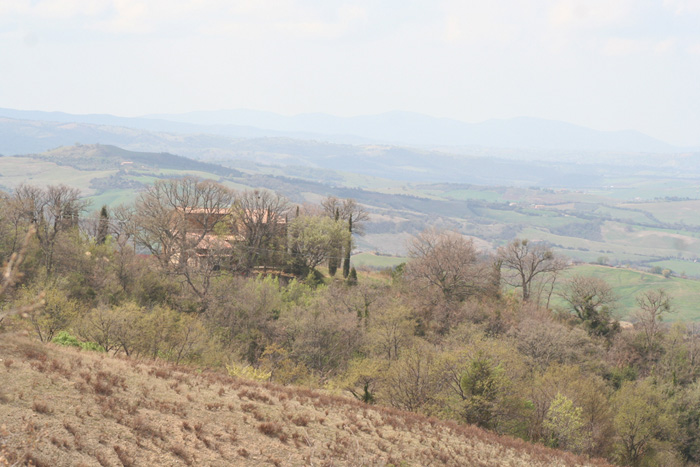 |
||||
Podere Santa Pia (April), situated in the green heart of Tuscany on top of a sunny hill overlooking the panoramic view towards the Maremma coast |
||||

